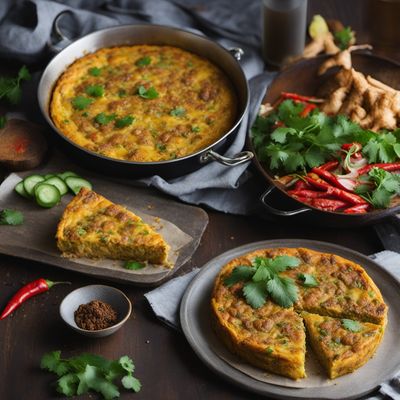
Recipe
Mee Bandung Rasa Malaysia
Spicy and Savory Malaysian Noodle Delight
4.7 out of 5
Indulge in the rich flavors of Malaysia with Mee Bandung Rasa Malaysia. This traditional dish combines spicy and savory elements to create a truly satisfying noodle experience.
Metadata
Preparation time
20 minutes
Cooking time
20 minutes
Total time
40 minutes
Yields
4 servings
Preparation difficulty
Medium
Suitable for
Pescatarian, Dairy-free, Gluten-free (if using gluten-free soy sauce and noodles), Nut-free, Low-fat
Allergens
Shellfish (shrimp), Soy (soy sauce)
Not suitable for
Vegan, Vegetarian, Paleo, Keto, High-protein
Ingredients
-
250g (8.8 oz) yellow noodles 250g (8.8 oz) yellow noodles
-
200g (7 oz) shrimp, peeled and deveined 200g (7 oz) shrimp, peeled and deveined
-
150g (5.3 oz) tofu, cubed 150g (5.3 oz) tofu, cubed
-
1 cup bean sprouts 1 cup bean sprouts
-
1 cup bok choy, chopped 1 cup bok choy, chopped
-
2 tablespoons dried shrimp 2 tablespoons dried shrimp
-
2 tablespoons chili paste 2 tablespoons chili paste
-
2 tablespoons tamarind juice 2 tablespoons tamarind juice
-
1 tablespoon soy sauce 1 tablespoon soy sauce
-
1 tablespoon fish sauce 1 tablespoon fish sauce
-
1 tablespoon vegetable oil 1 tablespoon vegetable oil
-
4 cups water 4 cups water
-
Salt, to taste Salt, to taste
Nutrition
- Calories (kcal / KJ): 350 kcal / 1465 KJ
- Fat (total, saturated): 8g, 1g
- Carbohydrates (total, sugars): 50g, 5g
- Protein: 20g
- Fiber: 5g
- Salt: 2g
Preparation
-
1.In a large pot, heat the vegetable oil over medium heat. Add the dried shrimp and chili paste, and cook until fragrant.
-
2.Add the shrimp to the pot and cook until they turn pink and opaque.
-
3.Pour in the water, tamarind juice, soy sauce, and fish sauce. Bring the mixture to a boil.
-
4.Reduce the heat to low and simmer for 10 minutes to allow the flavors to meld together.
-
5.Meanwhile, cook the yellow noodles according to the package instructions. Drain and set aside.
-
6.Add the tofu, bean sprouts, and bok choy to the pot. Cook for an additional 5 minutes until the vegetables are tender.
-
7.Season the broth with salt to taste.
-
8.Divide the cooked noodles into serving bowls and ladle the hot broth over them.
-
9.Garnish with fresh cilantro, sliced red chilies, and a squeeze of lime juice, if desired.
Treat your ingredients with care...
- Shrimp — Make sure to devein the shrimp properly to remove any grit or sand.
- Tofu — For a firmer texture, press the tofu before cubing it.
- Dried shrimp — Soak the dried shrimp in warm water for 10 minutes before using to soften them.
Tips & Tricks
- For a spicier version, add more chili paste or sliced fresh chilies.
- Customize the toppings by adding sliced boiled eggs, fried shallots, or chopped scallions.
- Adjust the tanginess by adding more or less tamarind juice according to your preference.
- If you prefer a thicker broth, dissolve 1 tablespoon of cornstarch in water and add it to the simmering broth.
- Leftover Mee Bandung can be stored in the refrigerator for up to 2 days. Reheat gently on the stovetop before serving.
Serving advice
Serve Mee Bandung hot in individual bowls, garnished with fresh cilantro, sliced red chilies, and a squeeze of lime juice. Accompany it with a side of sambal belacan (spicy shrimp paste) for an extra burst of flavor.
Presentation advice
To enhance the presentation, arrange the cooked noodles neatly in the center of the bowl and ladle the broth over them. Place the shrimp, tofu, and vegetables on top of the noodles, and garnish with fresh herbs and chili slices. Serve with a lime wedge on the side for an inviting touch.
More recipes...
For Malaysian cuisine » Browse all
More Malaysian cuisine dishes » Browse all

Kolo mee
Kolo Mee
Kolo mee is a popular Malaysian noodle dish that is perfect for a quick and satisfying meal. It is a combination of thin noodles, minced pork, and...

Kuih lapis
Kuih lapis is a traditional Malaysian cake that is made with coconut milk and pandan leaves. It is a layered cake that is typically served during...

Sarawak laksa
Coconut curry soup
Sarawak laksa is a spicy noodle soup that is popular in the Malaysian state of Sarawak. The soup is made with a spicy coconut milk broth and is...






